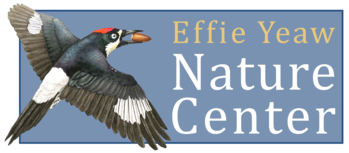Learn
We have many incredible bucks that roam the Nature Study Area. We often hear visitors mentioning large “horns” on bucks but they are actually antlers!
Antlers and horns belong to two different biological families: Bovidae and Cervidae. Mammals who are part of the Bovidae family and include bison buffalo antelope sheep goat and other cattle. Mammals that are part of the Cervidae family and include deer moose elk caribou and other species related.
A big difference between antlers and horns is that antlers shed annually in the winter; horns do not. Animals like deer moose and elk will shed their antlers every year and grow new ones. Each time they grow new antlers they are bigger and develop more points which can also help you determine the animal’s age. During the shedding process of a deer’s antlers for example the antlers will grow back with a velvety-like layer that covers the bone. When the antlers are finished growing the deer will scrape off the velvety layer using branches and other hard surfaces. They may even lick off the scrapings from whatever they used to help assist the removal! This velvety layer is full of vitamins and nutrients so deer love to ingest it. The growth and removal of this layer is not painful for the deer just a little itchy and annoying!
Horns on the other hand do not shed and are made up of a bony core covered with a sheath of keratin. Most of the growth happens in the earlier years of the animal and slows down as they age but they do grow consistently for their entire existence. In addition antlers grow only the male animal; horns grow on both males and females!
Animals with antlers (Cervidae): Deer (top left); Elk (top right); Moose (bottom left); Reindeer (bottom left).
Photo credits: Buck – Noppadol Paothong/MDC; Elk – Photo credit Getty Images; Moose – Ryan Hagerty/US Fish & Wildlife Service; Reindeer – Annika Thierfeld /Pexels
Animals with horns (Bovidae): Cattle (goats cows sheep) Antelope Buffalo/Bisonn
nPhoto credits: Goat – © Brian Squibb; Antelope – Colin Watts @imagefactory; Cow – Johnny Adolphson on Shutterstock; Buffalo- Annika Lewie Embling @trina24
Create
Make your own antlers or horns! In this craft activity students will:
1. Learn about the structure and purpose of antlers / horns.
2. Construct a headband modeling a pair of antlers / horns.
Click the picture to give it a try!
Activate
We invite you to come to the Effie Yeaw Nature Center trails and do a wildlife count to record how many deer you see! Note the date time weather start time end time route male/female age (adult/fawn) and note which direction they are moving on a map so you can decide later if you are counting the same deer already counted. Below is a link of our map and the wildlife count sheet.
Deer Observation Sheets
Nature Study Area Map
Resources
Find out more about horns and antlers.
Watch two young bucks sparring!
Good topics to discuss during your count:
• What are antlers and horns made of?
• What are antlers and horns used for?
• Do you think all animals have the same type of antlers and horns?

